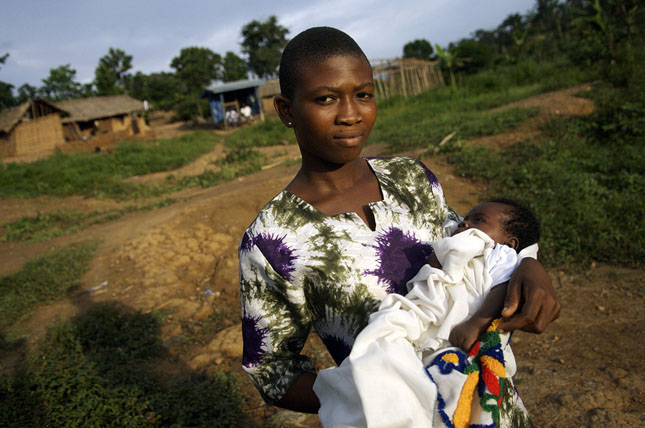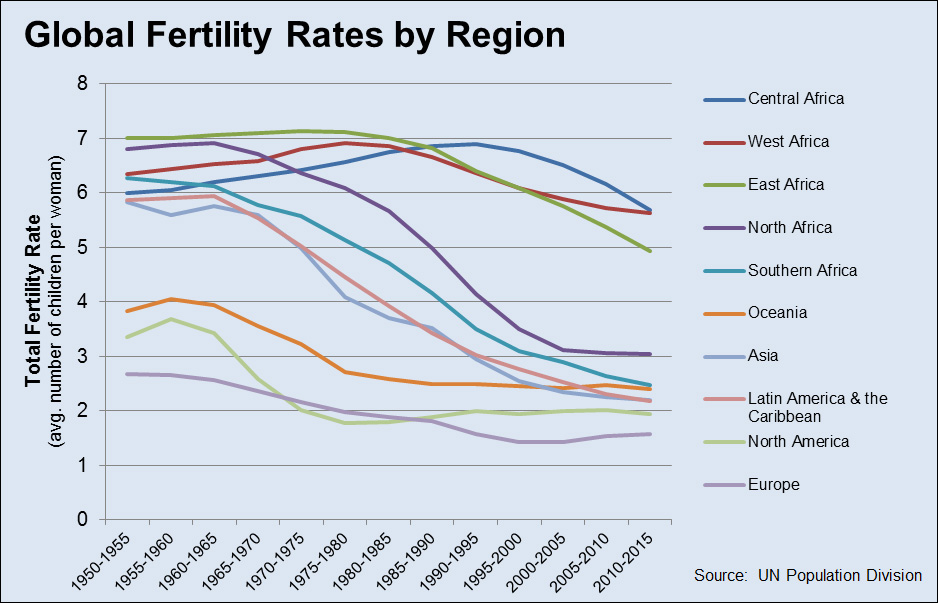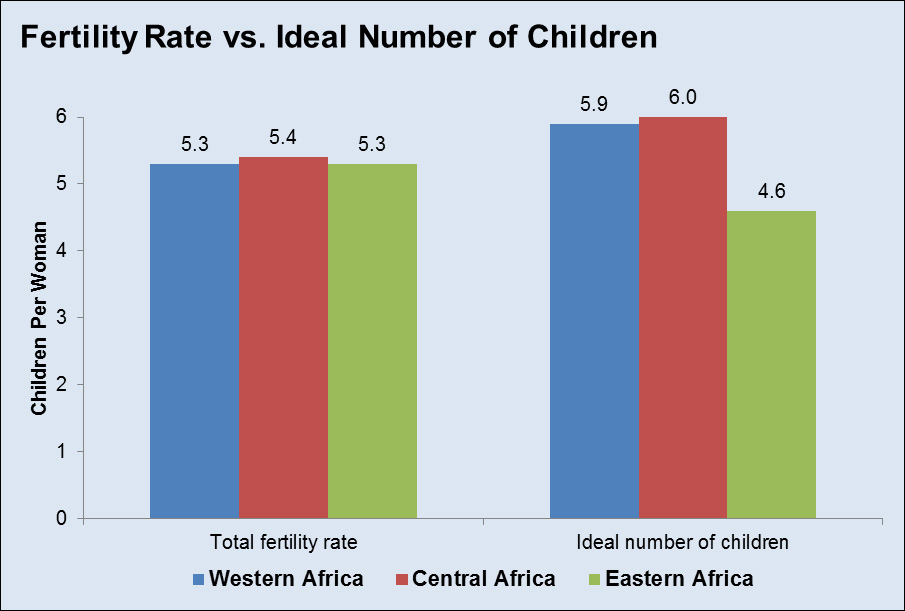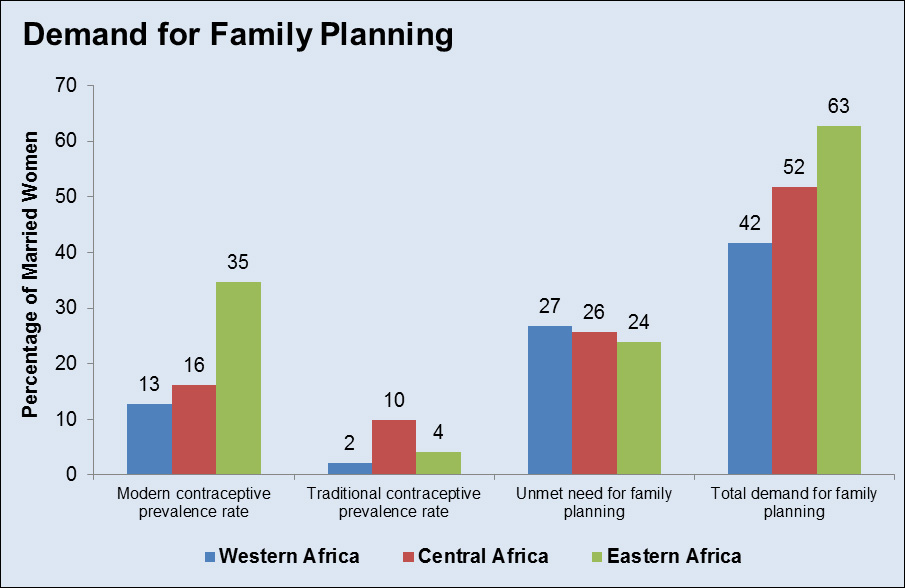-
What’s Behind West and Central Africa’s Youthful Demographics? High Desired Family Size
May 11, 2015 By Elizabeth Leahy Madsen
Sub-Saharan Africa is often characterized as an outlier in terms of population dynamics and reproductive health. While women are having fewer children around the world, even prompting some places to begin worrying about aging populations, the demographic transition is proceeding more slowly in Africa. Fertility rates in North and Southern Africa have declined to around three children per woman, but the three other sub-regions of the continent – East, Central, and West Africa – retain much higher fertility, between five and six children per woman. Whether, and how quickly, fertility rates decline in these regions over the next few decades will in large part determine the peak of world population. These regions’ demographic trajectories also have important implications for health, governance, food security, economic development, land use, climate vulnerability, and even security.
Every context is different, but an analysis conducted for 15 countries in West Africa, 8 countries in Central Africa, and 14 countries in East Africa using the most recent available data from the Demographic and Health Survey program and United Nations Population Division illustrates some broad trends. Demographic paths are moving in different directions in the three regions, with change likely to come slowest in West Africa.
Bucking a Trend
Many of the factors directly affecting fertility rates are similar across the three regions. For example, the average age of marriage for women is 18.5 years for West Africa, 18.9 for Central Africa, and 19.0 for East Africa. The key differences are in use of family planning and individual preferences about family size. East African countries have a much higher average contraceptive prevalence rate – 35 percent for modern methods – than those of Central (16 percent) and West Africa (13 percent).
Family planning use has increased markedly in several East African countries, such as Kenya, Malawi, and Rwanda. Newly released data from the Demographic and Health Survey and PMA2020 programs show more than 50 percent of married women in Kenya use modern contraception, and fertility has dropped below four children per woman from more than five just 10 years ago.
Meanwhile, countries in West Africa show some of the lowest contraceptive prevalence rates in the world. As measured by recent Demographic and Health Surveys, modern contraceptive prevalence is at or below 10 percent in Benin, Guinea, Mali, and Nigeria.
Although many interrelated factors are at play, fertility preferences are a major contributor to low use of family planning in West Africa. In other regions, efforts to expand family planning availability coincided with changing social attitudes. Women and couples began to prefer smaller families, likely due to improved child survival and female education and empowerment, spurring increased demand for contraception. But women and couples in West and Central Africa have retained a desire to have larger families. This suggests that while fertility in East Africa may show further decline in the near term, as evidenced by recent trends in Kenya and other countries, Central and West Africa are unlikely to follow a similar path in the near future.
Fertility Behavior and Preferences
Two indicators demonstrate how fertility preferences differ across West, Central, and East Africa. The ideal number of children is a hypothetical construct based on asking a woman how many children she would have if she could go back in time and choose the exact number. It is an imperfect measure because women are sometimes unwilling to provide a number lower than their actual number of children (thus implying that some of those children were unwanted) but still useful in gauging general preferences about family size.
There is a clear and distinctively different pattern in ideal number of children across the sub-Saharan African regions. In East Africa, women have an average of 5.3 children but say that their ideal family size is 4.6. Clearly, women are, on average, having more children than they would prefer. However, West and Central African women say that in an ideal world, their families would be even larger than they are: 5.9 children compared to 5.3 for West Africa and 6.0 compared to 5.4 for Central. Married women in Niger describe an ideal family size of 10 children – and this number has been increasing over time.
Ideal family size should not be taken literally. It may reflect social or cultural norms that favor large families, while the economic and other constraints that individual families and women face in raising children have greater influence in actual fertility decisions. Still, the very high ideal family size in West and Central Africa is an important factor in shaping fertility behavior. Across the continent, there is a clear positive relationship between ideal family size and actual fertility.
West and Central African women say in an ideal world their families would be even largerA second indicator that demonstrates how fertility preferences differ across the regions is the percentage of married women who say they want to have no more children. This measure removes the potential bias of ideal family size, as women are only asked to report the desirability of more children than they already have. In West and Central Africa, the proportions are nearly identical, at 24 and 25 percent. In East Africa, the proportion is much higher: 40 percent of married women wish to stop childbearing.
Contraceptive prevalence rates across the three regions are a reflection of these varied fertility preferences. In contrast, unmet need for family planning is similar across the three regions, between 24 and 27 percent. Although unmet need is often conceptualized as women’s inability to obtain the contraceptive services that they desire, it also includes women who would prefer to avoid pregnancy but have made a deliberate choice not to use family planning.
Women may choose not to use family planning despite a preference to avoid pregnancy for several reasons, including fear of side effects or other health concerns, infrequent sex, or personal, familial, or cultural opposition to family planning. In East Africa, the most common reason is concern about side effects (reported by 32 percent of women with unmet need), followed by opposition to family planning (23 percent). In West Africa, the reasons are reversed: 30 percent of women with an unmet need for contraception are not using it because of opposition to family planning, while 24 percent cite health concerns.
Contraceptive use and unmet need, added together, comprise total demand for family planning, or the proportion of married women who currently wish to avoid pregnancy. There is a clear gradation in this indicator across the three regions. Nearly two-thirds of married women in East Africa can be considered to have demand for family planning (62 percent of them are contraceptive users, and 38 percent have unmet need). Demand for family planning falls to 52 percent in Central Africa, and in West Africa, drops to 42 percent. This means that the majority of married women in West Africa do not currently wish to avoid pregnancy.
What Affects Fertility Preferences?
Several factors have been posited to influence fertility preferences, such as child mortality, economic development, and education. In brief, such theories suggest that couples will intentionally have more children if they expect some may die; that increasing wealth and urbanization will motivate preferences toward smaller families; and that educated women choose to have fewer children. Of these, the mortality and education theories have the strongest supporting evidence. Increases in per capita income are not strongly correlated with fertility declines, and urbanization does contribute to fertility decline, but to a lesser extent than education and mortality decline.
More than 10 percent of children die before their fifth birthdayAlthough child mortality rates have decreased around the world, they remain high in sub-Saharan Africa. More than 10 percent of children die before their fifth birthday in East, Central, and West Africa. While the rate is lowest in East Africa, the differences between the three regions are likely not large enough to explain all of the variation in fertility preferences.
This underscores the value of programs to improve educational attainment and quality. Increased education among women is well-established to lower fertility rates, and it is therefore no surprise that education affects fertility preferences as well. However, researchers have found that education and other socioeconomic factors do not explain all of the differences in fertility preferences. Even controlling for these indicators, sub-Saharan African countries have larger desired family sizes. In efforts to explain this finding, researchers have examined family planning programs and determined that, depending on their quality, they can affect fertility preferences too.
Better information about and access to family planning is important to meet existing levels of unmet need across sub-Saharan Africa, which are high. But one review of the evidence showed that the mere availability of family planning did not affect fertility preferences. Another study found that a significant effect on changing fertility preferences depended on the “effort,” or strength, of individual family planning programs, measured by experts’ assessment of a range of issues, such as official policies, favorable statements by leaders, legal regulations, national budgets, diverse distribution methods including community-based health workers and social marketing, logistics, training, outreach, evaluation, and availability of specific methods. Countries with similar social, economic, and cultural indicators, such as Kenya and Uganda, were paired. Women in countries with “weak” family planning programs reported desired family sizes 1.3 children higher than those in otherwise similar countries where family planning programs were stronger. This effect also existed across all countries when measured in the aggregate.
Moving Beyond the Status Quo
What are the implications of these differences? We should not expect West and Central Africa to follow the same demographic trajectory of other regions. Demographers are very clear that fertility rates will not decline to the levels seen in other regions unless preferences about family size change. Without this change, global population will reach the upper end of current projections. Further, the much-ballyhooed demographic dividend will remain elusive for many of these countries.
Individual fertility preferences must be respected, no matter how high or lowThese broader implications are ultimately secondary because the decision of how many children to have is an established human right. Individual fertility preferences must be respected, no matter how high or low. That said, fertility decisions reflect a complex mix of individual preferences and social context, both of which often evolve over time. Various development initiatives that have a range of benefits for families, communities, and societies also influence fertility preferences by shaping the social context in which such preferences are formed.
Among these, comprehensive, well-resourced, and inclusive family planning programs should remain a priority. Given that strong family planning programs seem to affect fertility preferences, providing information to increase demand could be a larger component of these efforts. A recent study found that women who participated in community and media outreach efforts were more likely to use modern contraception than those who did not. Political commitments that raise the prominence of family planning are also likely to influence individual attitudes, even if this effect is not easy to directly measure. In addition, investments in education have far-reaching benefits for a range of individual health and wellbeing outcomes, including gender equity. Women who are more empowered, as measured by their autonomy in decision-making, prefer smaller families. Education and outreach towards men cannot be neglected either. In most countries in these regions, men have a higher ideal number of children than women.
Long-term and concerted commitment will be required across multiple sectors, but there is no reason to assume that West Africa’s fertility preferences are immutable.
Elizabeth Leahy Madsen is a consultant on political demography for the Wilson Center’s Environmental Change and Security Program and senior technical advisor at Futures Group.
Sources: Bongaarts (2011), DHS Program, Sedgh and Hussain (2014), Shapiro and Gebreselassie (2009), Speizer et al. (2014), United Nations Population Division, Westoff (2010), World Bank.
Photo Credit: Mother and child in Adwenpaye, Ghana, courtesy of Jonathan Ernst/World Bank; Charts: Elizabeth Leahy Madsen and Schuyler Null, data from UN Population Division and Demographic and Health Surveys.
Topics: Africa, demography, development, economics, education, family planning, featured, gender, global health, Mali, Niger, Nigeria, population, Sahel, youth
 A Publication of the Stimson Center.
A Publication of the Stimson Center.






